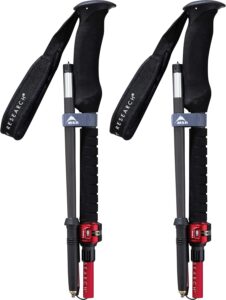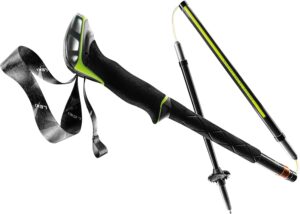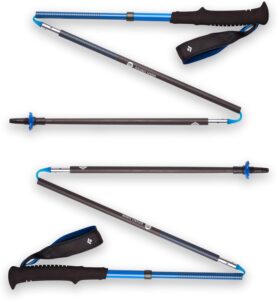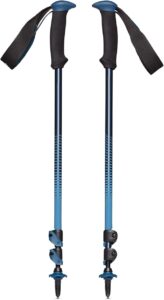7 Best Trekking Poles for Hiking
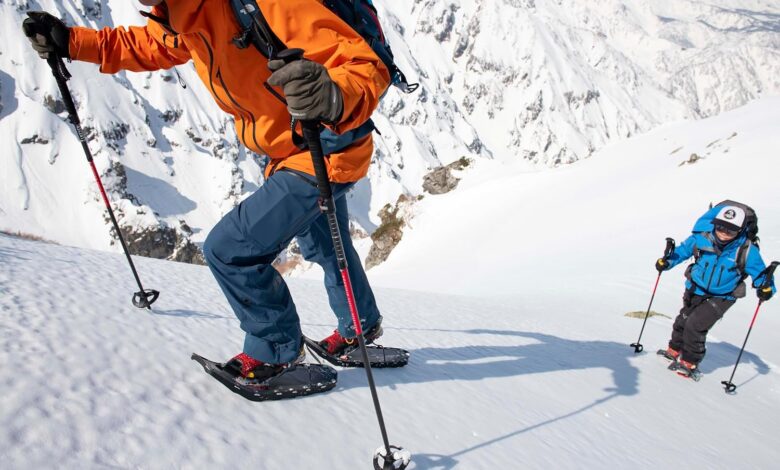
When I’m out on the trail, a good set of trekking poles can be the difference between a hike that I actually enjoy and a painful one. They’ve saved my knees on steep descents, helped me keep my balance on sketchy terrain, and made river crossings much less intimidating.
But with so many options available, finding the right pair can feel overwhelming. I’ve spent months testing different trekking poles across varied terrain to find the ones that truly work the best.
Whether you’re looking for something lightweight for fast-packing, sturdy poles for winter adventures, or budget-friendly options that won’t break the bank, I’ve got you covered.
In this guide, I’ll share my findings on the best trekking poles you can get along with tips on how to choose the right pair specifically for you and enjoy a safe hike.
How We Tested
My testing process was designed to replicate the conditions you’d actually encounter on the trail. I took each pair of the best hiking poles on multiple hikes spanning different terrains—from muddy forest paths to rocky alpine terrain, and even some snow-covered trails.
I evaluated each pole based on several key factors, like comfort, durability, weight, packability, versatility, and value. This meant putting them through their paces in various scenarios—using them to maintain balance on steep descents, testing their stability when crossing streams, and seeing how well they packed down when not using them.
While testing these poles, I made sure to include several rainy day hikes, as trekking poles become even more necessary when trails get slick and muddy.
Each pole was used for a minimum of 15 miles of hiking, with many models seeing significantly more trail time. I also enlisted several fellow hikers of different heights and hiking styles to get feedback on each model.
While trekking poles are essential gear for most hikers, don’t forget that proper footwear, moisture-wicking layers, and weather-appropriate clothing are just as important—I typically wear lightweight hiking pants, a breathable long-sleeve shirt, and a packable rain jacket even on fair-weather days, as conditions can change rapidly on the trail.
1. MSR DynaLock Ascent Carbon
Best Overall Trekking Pole
The MSR DynaLock Ascent Carbon poles are my top pick after extensive testing. These are some of the best trekking poles that offer a great balance of weight, and they’re durable, which is hard to beat. At 17 ounces per pair, they’re light enough for long-distance treks but sturdy enough to handle rough terrain and heavy packs.
Unlike a camping axe which adds substantial weight to your pack but serves only limited purposes, these trekking poles are lightweight multi-taskers that earn their keep with every step on the trail.
I love the construction of these poles because they have Kevlar-reinforced carbon fiber shafts that provide superior strength without adding significant weight, and the folding design allows them to collapse down to just 14.3 inches, making them easily packable.
When I needed to stash them in my backpack for a scrambling section, they disappeared easily without awkwardly sticking out. The grip is another standout feature—simple yet ergonomic EVA foam that remained comfortable even after hours on the trail.
The DynaLock mechanism is simple and secure, so you can make quick adjustments on the fly without any slippage issues that plague lesser poles. I was especially impressed by how these poles performed across different activities, from day hiking to backpacking and even light mountaineering, making them an excellent investment for anyone looking for one pole to do it all.
2. Leki Sherpa FX Carbon
Best for Winter
When the temperatures drop and the terrain gets more challenging, the Leki Sherpa FX Carbon poles are a good choice. These poles have a smart hybrid construction with aluminum in the lower sections for durability and carbon fiber in the upper portions to save weight. This combination proved to be ideal for winter conditions where poles face more abuse.
During my winter testing, these poles stood up to post-holing in deep snow, navigating icy sections, and supporting me while carrying a heavier winter pack. The extended foam grip provides multiple hand positions, which I found incredibly useful when side-hilling across steep slopes.
The Aergon air foam grip stayed comfortable even when I was wearing thick gloves, and the secure locking strap prevented me from dropping a pole in deep snow.
What impressed me most was the powder basket—wide enough to provide flotation in snow but still flexible enough to use for flipping heel risers on ski tours—and I found these poles paired perfectly with my 3-liter hydration bladder, as the security they provided allowed me to drink on the move without stopping, even on technical terrain.
After a long day of winter hiking with these poles, nothing beats setting up camp and heating water in a lightweight camping kettle for a hot drink—the stability these poles provide even helps when you’re tired and setting up your kitchen on uneven snow.
At 1 pound and 1 ounce, they’re slightly heavier than some ultralight options, but their durability and functionality in winter conditions more than justify the extra weight. They collapse down to a respectable 16 inches, making them some of the best collapsible hiking poles that are packable enough for mountaineering and backcountry adventures.
3. Trekology Trek-Z 2.0
Best Budget Trekking Pole
Finding good budget trekking poles can be tricky, but the Trekology Trek-Z 2.0 delivers impressive performance at a fraction of the cost of premium models. At around $45, these poles offer features typically found on poles twice the price, making them an excellent value for occasional hikers or if you’re just getting into trekking poles.
The most surprising aspect of these poles is their foldable Z-style design, typically a feature reserved for more expensive models. This allows them to pack down to just 15 inches, comparable to many higher-end poles.
Because of the aluminum construction, these poles provide good durability, and I even found the EVA foam grips comfortable enough for day hikes and weekend backpacking trips. The main trade-off is weight—at 26 ounces per pair, they’re notably heavier than carbon alternatives. This extra weight became noticeable on longer hikes, especially when making quick movements.
Even though the locking mechanism is functional, it doesn’t inspire the same confidence as those on premium poles, so for the casual hiker or someone wanting to try trekking poles without a big investment, these poles offer tremendous value and surprisingly capable performance.
4. Black Diamond Distance Carbon Z
Best Lightweight Trekking Poles
If you’re looking for extra light trekking poles or if you’re a fast packer, the Black Diamond Distance Carbon Z poles are a game-changer. Weighing just 10.2 ounces per pair, they’re among the lightest options available without compromising too much on functionality. The first time I picked them up, I was almost surprised by how little they weighed.
These fixed-length poles use a minimalist design to save weight—there’s no length adjustment mechanism, which eliminates moving parts that could fail and saves precious ounces. The carbon fiber construction feels surprisingly strong for something so lightweight, though I’d be more careful with these on especially rocky terrain.
The Z-pole folding design allows them to collapse down to a mere 13 inches, making them the most packable option in my test. While they aren’t adjustable, they excel at their intended purpose, which is moving fast and light on the trail.
I found them perfect for trail running and ultralight backpacking where every ounce matters. The foam grips are adequate rather than plush, but they get the job done without adding weight.
These poles come in four fixed sizes (100cm, 110cm, 120cm, and 130cm), so be sure to choose the right length for your height. If you’re focused on minimizing pack weight without giving up the benefits of trekking poles, the Distance Carbon Z is the clear winner.
5. Leki Cressida FX Carbon
Best Women’s Trekking Pole
The Leki Cressida FX Carbon poles are thoughtfully designed with features that address the specific needs of women and smaller-framed hikers. These aren’t just “shrink it and pink it” poles, but they have meaningful design differences that are more comfortable.
My most noticeable difference is in the grip design, slightly smaller in diameter and with contours that better fit smaller hands. The soft cork material proved immediately to be comfortable and it continued to mold to my hand over time, reducing fatigue on longer hikes.
The pole shaft diameter is also designed for smaller hands, providing better control and reducing strain during extended use. Beyond the women-specific features, these are simply excellent poles. The carbon fiber construction keeps weight reasonable at 17 ounces per pair, while still providing good vibration dampening on rocky terrain.
I also like the 5.5-inch grip extension because it offers flexibility for quickly adjusting hand position on the terrain without stopping to adjust pole length. With a collapse length of 16 inches, they’re pretty packable for travel or storing in your pack.
6. ALPS Mountaineering Alliance
The ALPS Mountaineering Alliance poles hit a sweet spot between performance and price which makes them an excellent choice for regular hikers who want quality without breaking the bank. These poles use a hybrid construction with carbon fiber upper sections and aluminum lowers, so they are both lightweight and durable.
During testing, I was impressed by how these poles handled moderate backpacking trips. At 15.2 ounces per pair, they’re reasonably lightweight, and the EVA foam grips remained comfortable even on sweaty days. The external locking mechanism was reliable once properly tensioned, though I did have to retighten it occasionally during the first few uses.
My only complaint was with the strap design—the block connecting the strap to the pole sits right where I wanted to place my hand, creating a minor but noticeable comfort issue. Otherwise, these poles performed well across a range of conditions.
They pack down to 24.5 inches, which isn’t as compact as folding poles but it’s still manageable for most backpacks. For someone stepping up from entry-level poles but not ready to invest in premium models, the Alliance offers solid performance at a reasonable price.
7. Black Diamond Trail Back
For hikers who prioritize reliability and longevity over weight savings, the Black Diamond Trail Back poles are a great choice. As one of the best trekking poles, these aluminum poles are built like tanks, and they’re designed to handle years of abuse on the trail without failing when you need them most.
The three-section telescoping design uses Black Diamond’s reliable FlickLock system, which I found exceptionally secure even when putting my full weight on the poles during steep descents. There was zero slippage, even after extended use in wet conditions.
The aluminum construction can take a beating—I accidentally caught one pole between rocks during testing, and even though it bent slightly, I was able to bend it back into shape without compromising its integrity (something you can’t do with carbon fiber).
At around 20 ounces per pair, they’re certainly not the lightest option, but the trade-off for durability is worth it for many hikers, especially if you’re carrying heavy packs or hiking in challenging terrain.
The foam grips aren’t as premium as cork options but performed fine in most conditions. These poles don’t pack down as small as folding models, collapsing to about 25 inches, but they’re an excellent choice for hikers who want a dependable pole that will last for many seasons without requiring delicate handling.
How to Choose the Best Trekking Poles
Finding the good trekking poles that are right for you means considering several key factors that will affect your experience on the trail. Here’s what to look for in the best walking sticks:
Length
The proper length for your trekking poles depends on your height and the terrain you’ll be hiking. As a general guideline, when holding the pole with the tip on the ground next to your foot, your elbow should form a 90-degree angle.
Most poles these days are adjustable, which is ideal since you can shorten them for uphill sections, reducing arm strain, and lengthen them for downhill sections, providing more support.
Fixed-length poles save weight but aren’t as adaptable. If you go with fixed-length poles, be sure to choose the right size for your height—typically, your height in centimeters minus 40 gives you a good starting point.
Aluminum vs Carbon Fiber
Aluminum poles are usually more durable and less expensive, and they can bend under pressure rather than break, which means they might still be usable after an accident. Plus they’re heavier than carbon fiber alternatives.
Carbon fiber poles are lighter, sometimes by several ounces per pair, and absorb shock better, reducing the impact on your joints, but the downside is that they’re more expensive and can shatter if they’re under extreme stress.
Locking Mechanism
The locking mechanism is what keeps adjustable poles at your desired length. There are three main types:
- Lever locks, also called FlickLocks or external locks, are the most reliable and easiest to use, even with gloves on. They can usually be tightened without tools when they begin to wear.
- Twist locks are lighter and less bulky but can be more prone to slipping, especially when wet or cold. They can also freeze up in winter conditions.
- Push-button locks are found on folding poles and allow for quick assembly but typically offer limited or no adjustability.
I’ve found lever locks to be the most reliable option for serious hiking, while twist locks work fine for occasional use in fair weather.
Baskets and Tips
Different tips and baskets allow the best walking sticks to adapt to various terrain conditions:
- Carbide tips provide excellent traction on most surfaces and are extremely durable. Some poles include rubber tip covers for use on sensitive surfaces or pavement.
- Trekking baskets are small discs that prevent your poles from sinking too deeply into soft ground. They’re the standard for most three-season hiking.
- Snow baskets are larger to provide flotation in snow. Many poles allow you to switch between trekking and snow baskets, increasing versatility.
Some newer poles feature specialty tips like the crossover tip from TSL, which has multiple points of contact for better grip on varied terrain.
Quality
The overall construction quality of trekking poles significantly impacts their lifespan and performance. You should look for:
- Durable connection points between sections
- Comfortable grips made of quality materials (cork or good EVA foam)
- Secure, non-slip locking mechanisms
- Well-designed straps that distribute pressure evenly
Higher-quality poles may cost more initially but often provide better value over time as they last longer and perform more reliably.
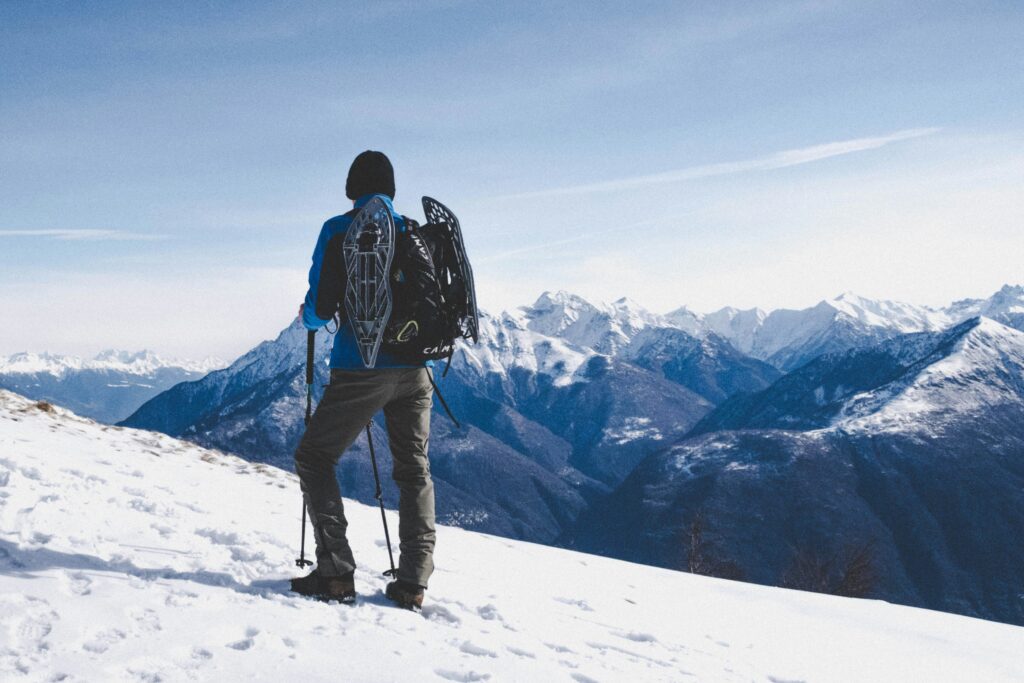
How to Efficiently Use Trekking Poles
For flat terrain, hold your poles with a relaxed grip and establish a rhythm where the opposite arm and leg move together—right pole forward with left foot, and vice versa. This creates a natural four-point contact with the ground that improves stability and can increase hiking speed.
When ascending, slightly shorten your poles, about 5-10 cm, and use them to push off, transferring some of the workload from your legs to your upper body. Plant the pole with each step and push down and back as you move forward.
For descents, lengthen your poles, again, about 5-10 cm, and place them ahead of you to brake your momentum and reduce impact on your knees. Keep your arms slightly bent and use the poles to control your speed.
When traversing slopes, adjust one pole to be shorter, the uphill pole, and one to be longer, the downhill pole. This maintains the proper arm angle on uneven terrain. Alternatively, if your poles have extended grips, you can simply grip the uphill pole lower on the shaft.
For stream crossings, set your poles on the downstream side to create a tripod effect with your legs, and move deliberately to maintain balance.
How to Size Trekking Poles
For a quick estimate, stand up straight and hold your arms at your sides, bent at a 90-degree angle at the elbow. The proper pole length is one that allows your hand to hold the grip in this position while the tip touches the ground.
A more precise method is to start with a pole length equal to your height in centimeters minus 40. For example, if you’re 175cm tall (5’9″), start with poles around 135cm long. Then fine-tune based on your preference and terrain.
Remember that adjustable poles let you modify length based on the terrain:
- Standard position: Elbow at 90 degrees
- Uphill: Shorten poles by 5-10 cm
- Downhill: Lengthen poles by 5-10 cm
- Traversing: Shorten the uphill pole and lengthen the downhill pole
If you’re between sizes for fixed-length poles, it’s usually better to size down rather than up, as it’s easier to compensate for poles that are slightly too short than ones that are too long.
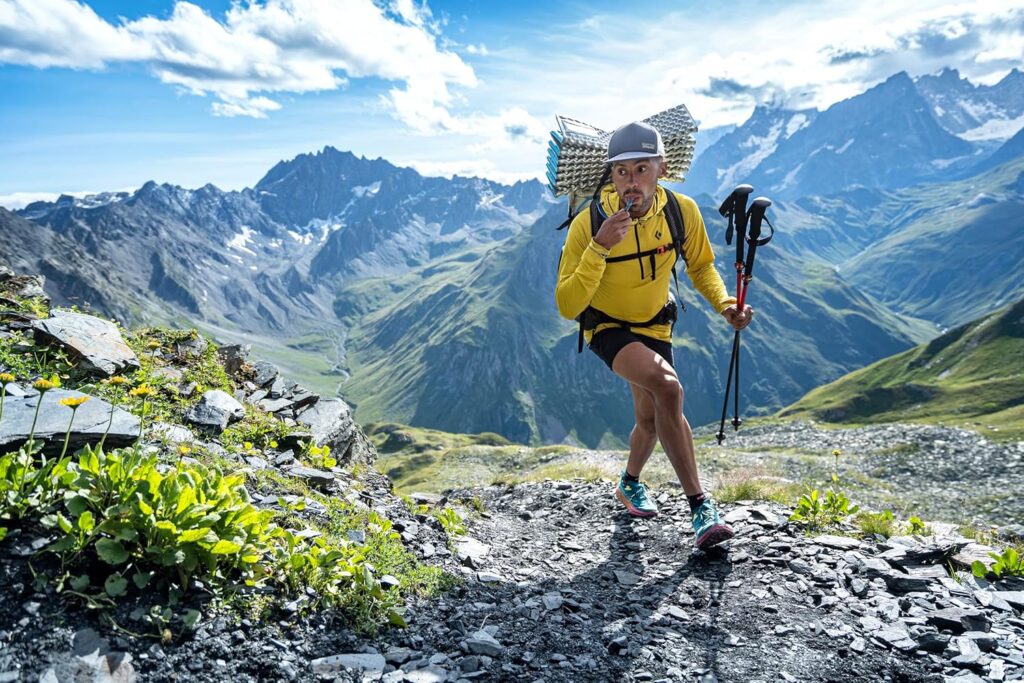
The Best Walking Poles: Frequently Asked Questions
Do I need one or two trekking poles?
While two poles provide the most stability and distribute the workload most evenly across your body, some hikers prefer using just one pole. A single pole frees up one hand for other tasks like taking photos, checking maps, or grabbing snacks without stopping. It also weighs less and can be easier to manage in tight spaces or when scrambling.
Two poles offer better balance, more support for your knees, especially on descents, and create a more efficient four-point contact with the ground. They’re especially beneficial when carrying heavy loads or hiking on challenging terrain.
If you’re trying to save weight but want the option of two poles in difficult sections, consider using a single collapsible pole that can be easily stowed when not needed.
How do men’s and women’s-specific poles differ?
Women’s-specific poles aren’t just marketing—they have genuine design differences that can improve comfort for women and smaller-framed hikers:
- Smaller-diameter grips that better fit smaller hands
- Shorter maximum lengths to accommodate shorter average heights
- Sometimes narrower shaft diameters for easier gripping
- Strap designs optimized for smaller wrists
- Often lighter overall weight
Regardless of gender, you can use poles marked for any gender as long as it feels comfortable for you.
Is there a difference between hiking poles and trekking poles?
Hiking poles and trekking poles are often used interchangeably, and both products will work well for both activities. There can be subtle differences in marketing:
- Hiking poles are more simply designed and are intended for day hikes on established trails.
- Trekking poles are more technical and are designed for longer journeys, off-trail travel, or more challenging terrain.
- Walking poles or walking sticks are designed for flat terrain and less technical use, and are usually more comfortable.
Final Thoughts
After months of testing all of the best trekking poles across varied terrain, the MSR DynaLock Ascent Carbon stands out as the best overall trekking pole, offering an exceptional balance of weight, durability, and versatility.
For winter adventures, the Leki Sherpa FX Carbon provides the reliability needed in challenging conditions. Budget-conscious hikers will appreciate the surprising quality of the Trekology Trek-Z 2.0.
The right trekking poles can completely change your hiking experience, reducing impact on your joints, improving balance and stability, and even increasing your pace. By considering your specific needs in terms of terrain, typical usage, and physical requirements, you can find good trekking poles that will last you for years.
Whether you’re a casual day hiker or a dedicated long-distance trekker, investing in quality walking poles is one of the most impactful gear decisions you can make for improving comfort and performance on the trail. Your knees will thank you—especially on those long downhill stretches.

